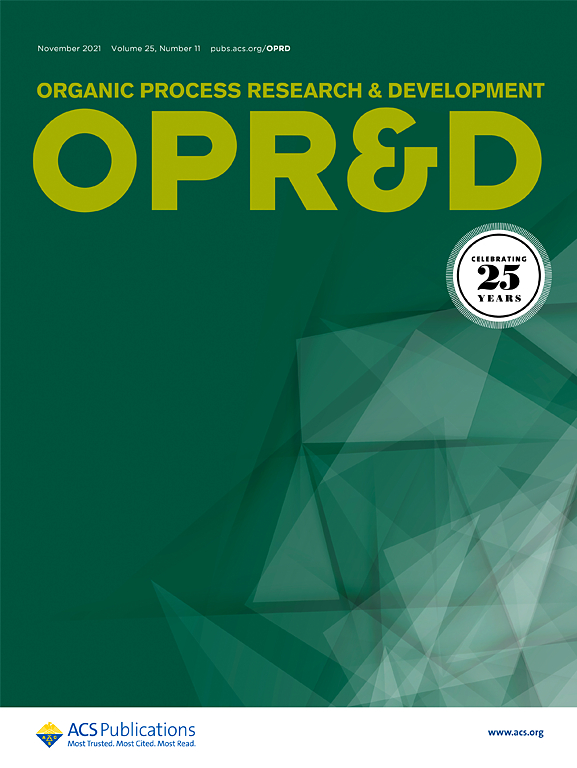环丙酚的实用和可扩展生产工艺的发展
IF 3.1
3区 化学
Q2 CHEMISTRY, APPLIED
引用次数: 0
摘要
环丙酚是一种新型的临床麻醉剂,由于其副作用较小,被认为是异丙酚的更好替代品。本文报道了一种原子经济、成本高效的环丙酚制备工艺,该工艺包括苯酚的区域选择性对卤化,然后是酯化和Fries重排,收率高。该策略采用对卤化,避免了在Fries重排过程中对副产物的产生。经过溴的良性还原和Wittig反应,通过钌催化的不对称氢化反应得到所需的环丙酚。这种新工艺已经在多图规模上进行了测试,总体收率提高了60%,成本效率提高了,同时具有原子经济优势。避免了先前报道的合成中clisen重排的低产率和昂贵的腐蚀性试剂的使用。本文章由计算机程序翻译,如有差异,请以英文原文为准。

Development of a Practical and Scalable Manufacturing Process for Ciprofol
Ciprofol is a novel clinical anesthetic and is deemed a better alternative to propofol due to its fewer side effects. Herein, we report an atom-economical and cost-efficient manufacturing process to prepare Ciprofol, which includes regioselective para-halogenation of phenol, followed by esterification and Fries rearrangement in high yields. This strategy adopts para-halogenation to avoid the generation of para-byproducts in the Fries rearrangement. After a benign reduction of bromine and the Wittig reaction, the desired Ciprofol is achieved by ruthenium-catalyzed asymmetric hydrogenation. This new process has been tested on a multigram scale, with an improved overall yield of 60% and enhanced cost efficiency, while offering atom economy advantages. The low yield of the Claisen rearrangement and the use of costly and corrosive reagents in the previously reported synthesis were avoided.
求助全文
通过发布文献求助,成功后即可免费获取论文全文。
去求助
来源期刊
CiteScore
6.90
自引率
14.70%
发文量
251
审稿时长
2 months
期刊介绍:
The journal Organic Process Research & Development serves as a communication tool between industrial chemists and chemists working in universities and research institutes. As such, it reports original work from the broad field of industrial process chemistry but also presents academic results that are relevant, or potentially relevant, to industrial applications. Process chemistry is the science that enables the safe, environmentally benign and ultimately economical manufacturing of organic compounds that are required in larger amounts to help address the needs of society. Consequently, the Journal encompasses every aspect of organic chemistry, including all aspects of catalysis, synthetic methodology development and synthetic strategy exploration, but also includes aspects from analytical and solid-state chemistry and chemical engineering, such as work-up tools,process safety, or flow-chemistry. The goal of development and optimization of chemical reactions and processes is their transfer to a larger scale; original work describing such studies and the actual implementation on scale is highly relevant to the journal. However, studies on new developments from either industry, research institutes or academia that have not yet been demonstrated on scale, but where an industrial utility can be expected and where the study has addressed important prerequisites for a scale-up and has given confidence into the reliability and practicality of the chemistry, also serve the mission of OPR&D as a communication tool between the different contributors to the field.

 求助内容:
求助内容: 应助结果提醒方式:
应助结果提醒方式:


